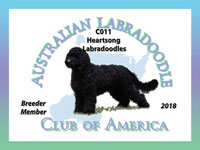Therapy Dog Bibliography
Allen KM, Blascovitch J, Tomaka J Kelsey RM (1991), Presence of human friends and pet dogs as moderators of autonomic responses to stress in women. J Pers Soc Psychol 61(4):582-589.
Anderson WP, Reid CM, Jennings GL (1992), Pet Ownership and risk factors for cardiovascular disease. Med J Aust 157(5):298-301.
Arnold JC (1995), Therapy dogs and the dissociative patient: Preliminary observations. Dissociation 8(4):247-252.
Barba BE (1995), The positive influence of animals: Animal assisted therapy in acute care. Clin Nurs Spec 9(4):199-202
Barker, SB (1993), Pet owners no longer grieve alone. Am Counselor 2(4):26-31.
Barker, SB, Barker, RT (1990), Investigation of the construct validity of the Family Life Space Diagram. J Ment Health Counseling 12:506-514.
Barker, SB, ;Barker, RT (1998), The human-canine bond: Closer than family ties? J Ment Health Counseling 10:46-56.
Barker, SB (1998), The effects of animal-assisted therapy on anxiety ratings of hospitalized psychiatric patients. Psychiatr Serv 49(6):797-801.
Barker SB, Dawson KS, Knisely JS (1997), The use of the family life space diagram in esablishing interconnectedness: a preliminary study of sexual abuse survivors, their significant others and pets. Individual Psychol 53 (4):435-450.
Batson K, McCabe BW, Baun MM et al. (1995), The effect of a therapy dog on socialization and physiologic indicators of stress in persons diagnosed with Alzheimer's disease. Animals, Health and Quality of Life: Abstract Book. Paris, France: AFIRAC.
Beck A, Seraydarian L, Hunter GF (1986) The use of animals in the rehabilitation of psychiatric inpatients. Pschol Rep 58(1):63-66.
Blue GF (1986), The value of pets in children's lives. Childhood Education 24:85-89.
Brickel Cm (1980), A review of the roles of pet animals in psychotherapy and with the elderly. Int J Aging Hum Dev 12(2):119-128.
Brown BH, Richars HC, Wilson CA (1996), Pet bonding and pet bereavement among adolescents. J Counseling and Development 74:505-509.
Bryant BK (1990), The richness of the child-pet relationship: a consideration of both benefits and costs of pets to children. Anthrozoos 3:253-261.
Campbell C, Katcher A (1992), Animal assisted therapy dogs for autistic children: Quantitative and qualitative results. Presented at the Sixth International Conference on Human-Animal Interactions. Montreal.
Corson SA, Corson EO (1978), Pets as mediators of therapy. Curr Psychiatr Ther 18:195-202.
DePauw K (1984), Therapeutic horseback riding in Europe and America. In: The Pet Connection: Its Influence on Our Health and Daily Life, Anderson RK, Hart BL, Hart LA eds. Minneapolis: Center to study Human_ Animal Relationships and Environments, pp 141-153.
Draper RJ, Gerber GJ, Laying EM (1900), Defining the role of pet animals in Psychotherapy, Psychiatr J Univ Ott 15(3):169-172.
Erikson EH (1964), Childhood and society. New York: Norton.
Francis G, Turner JT, Johnson SB (1985), Domestic animal visitation as therapy
with adult home residents. Int J Nurs Stud 22(3): 201-206.
Friedmann E, Katcher AH, Lynch JJ, Thomas SA (1980), Animal companions and one-year survival of patients after discharge from a coronary care unit. Public Health Rep 95(4):307-312.
Friedmann E, Katcher AH, Thomas SA et al (1983), Social Interaction and blood pressure: Influence of companion animals. J Nerv Ment Dis 171(8):461-465.
Fritz CL, Farver TB, Kass PH, Hart La (1995), Association with companion animals and the expression of noncognitive symptoms in Alzheimer's patients. J Nerv Ment Dis 183-459-463.
Hundley J (1991), Pet Project: The use of pet facilitated therapy among the chronically mentally ill. J Psychosoc Nurs Ment Health Serv 29(6): 23-26.
Katcher AH, Segal H, Beck A (1984), The use of animal assisted therapy and education with attention-deficit hyperactive and conduct disorders. Interactions 12 (4):1-5.
Klingel M (1991), Dolphincare: A therapeutic recreation program for emotionally disturbed adolescents. Presented at the Tenth Annual Delta Society Conference. Portland, Ore.
Lago D, Delaney M, Miller M et al. (1989), Companion animals, attitudes towards pets, and health outcomes among the elderly: a long-term follow-up. Anthrozoos 3:25-34.
Levinson BM (1962), The dog as co-therapist. Ment Hyg 46:59-65.
Mallon GP (1992), Utilization of animals as therapeutic adjuncts with children and youth: a review of the literature. Child and Youth Care Forum 21:53-67.
Nagengast SL, Baun MM, Leibowitz MJ, Megal M (1993), The effects of the presence of a companion animal on phsiological and behavioral distress in children during a physical examination. Presented at the Delta Society 12th Annuall Conference on the Interactions of people and Animals, St. Louis.
Nathanson DE, de Faria S (1993), Cognitive improvement of children in water with and without dolphins Anthrozoos 6(1):17-29.
Nebbe L (1998), The Human-Animal Bond's Role with the Abused Child. Presented at the Delta Society 17th Annual Conference. Seattle.
Patronek GJ, Glickman LT (1993), Pet ownership protects against risks and consequences of coronary heart disease. Med Hypotheses 40(4):245-249.
Pet theories. Psychology Today Aug 1984, pp 620-67.
Poresky RH, Hendrix C (1990), Differential effects of pet presence and pet-bonding on young children. Psychol Rep 67(1):51-54.
Robin M, ten Bensel R (1990), Pets and the socialization of children. Lathum Letter 11(2):1-23.
Schneidhacker M (1994), Die arbeit mit dem pferd in psychiatrie and psychotherapie (Working with the horse in psychiatry and psychotherapy) Warendorf, Germany: Schnell, Buch & Druck.
Searles H (1960), The Nonhuman Environment in Normal Development of Schizophrenia. New York: International Universities Press.
Serpell J (1991), Beneficial effects of pet ownership on some aspects of human health and behavior. J R Soc Med 84(12):717-720.
Siegel Jm (1990), Stressful life events and use of physician services among the elderly: the moderating role of pet ownership. J Pers Soc Psychol 58(6):1081-1086.
Van Houtte BA, Jarvis PA 91995), The role of pets in preadolescent psychosocial development. J Appl Dev Psychol 16:463-479.
Voelker R (1995), Puppy love can be therapeutic, too. JAMA, 274(24): 1897-1899. Published erratum: JAMA 275 (13):988.
Voith VL (1985), Attachment of people to companion animals. Vet Clin North AM Small Anim Pract 15(2):289-295.
Wells M (1998), Dog presence effects on children's stress responses during medical procedures. Presented at the Delta Society 17th Annual Conference. Seattle.
